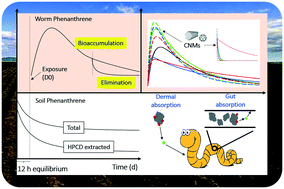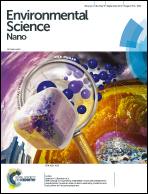Influence of multi-walled carbon nanotubes and fullerenes on the bioaccumulation and elimination kinetics of phenanthrene in geophagous earthworms (Metaphire guillelmi)†
Abstract
The impact of multi-walled carbon nanotubes (outer diameter <8 nm: MW8; >50 nm: MW50) and fullerene (C60) at 300 or 3000 mg kg−1 on phenanthrene bioaccumulation and elimination kinetics (L, 1.37 mg kg−1; H, 16.14 mg kg−1) in a geophagous earthworm (Metaphire guillelmi) was investigated. Prior to worm exposure, the residual phenanthrene concentrations in soil decreased by 56.4% (L) and 59.9% (H) after 12 h of equilibrium. Phenanthrene accumulation in earthworms exhibited a bell-shaped pattern for all treatments. However, both the rate and extent of bioaccumulation and elimination were significantly affected by the CNMs, dependent on both the type and amendment level. C60 and MW8 at 300 mg kg−1 in the L system significantly decreased the uptake rate of phenanthrene, resulting in delayed maximum accumulation at 2 d. All other treatments had little impact on the uptake rate, with the exception of a slight decrease induced by MW8 at 3000 mg kg−1. The maximum phenanthrene accumulation followed an order of C60 > MW8 > MW50 at each amendment level of these materials. All CNMs increased the uptake rate of phenanthrene by earthworms in the H system, with the exception of MW8 at 3000 mg kg−1 where the maximum accumulation occurred earlier than the control. Furthermore, the uptake rate and maximum accumulation of phenanthrene in earthworms followed an order of C60 > MW50 > MW8 at each level, which was the opposite of its strength of sorption to these materials. Interestingly, phenanthrene bioaccumulation in the H system amended with 3000 mg kg−1 MW8 was 2.2–3.9 times that of all the other treatments at 35 d. For elimination, MW8 at this level increased phenanthrene amounts remaining in earthworms in both L (1.4–3.2 times) and H (1.1–15.2 times) systems. A higher burden of phenanthrene during the later bioaccumulation and elimination periods could result from ingestion and absorption of MW8; the accumulated phenanthrene may strongly bind to the internalized MW8, thereby reducing its elimination. Soil amendment with C60 and MW50 at both levels and MW8 at 300 mg kg−1 increased worm phenanthrene elimination in the L system, while that in the H system was not significantly affected. The results highlight the impact of CNMs on the bioaccumulation and elimination kinetics of phenanthrene in a typical geophagous earthworm, and provide important information for understanding of the potential risks of CNMs released into terrestrial systems.



 Please wait while we load your content...
Please wait while we load your content...